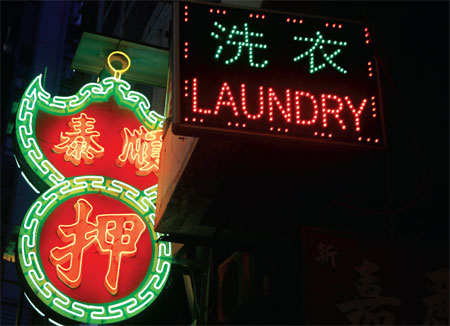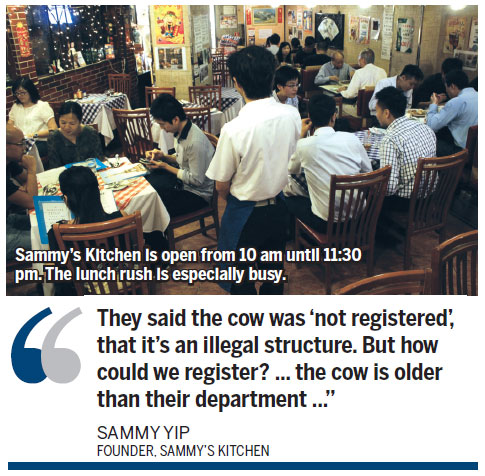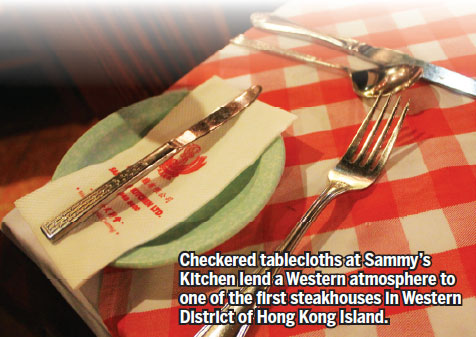Greener pastures for the neon cow
Updated: 2013-10-04 07:16
By Doug Meigs(HK Edition)
|
|||||||
|
The Buildings Department ordered Sammy's Kitchen to remove the restaurant's iconic neon cow two years ago. After repeated delays, a government-run museum plans to save the landmark from destruction. Doug Meigs / China Daily |


The neon sign over Sammy's Kitchen is Sai Ying Pun landmark. It's also an illegal structure. The Buildings Department ordered the sign removed, and when all hope of saving the structure seemed lost, the hand of a rescuer reached out. Doug Meigs reports.
It was to be the knacker's for the neon cow. The beast that had proclaimed "Sammy's Kitchen Ltd" in dyspeptic green lettering for more than three decades had presided over Queen's Road West in Sai Ying Pun. For that reason, a certain melancholy attached to the all but certain demise of the otherwise undistinguished ruminant of indeterminate gender, presenting evidence of neither horns nor udder. Its placid countenance was unmistakably bovine and its only notable quality was its solitary, cyclopean, blue eye.
To the casual passerby, it would otherwise be easy to miss Sammy's Kitchen Ltd, despite the fact that over the years it's catered to thousands of ordinary diners, celebrities and high government officials. The restaurant is tucked in behind an opaque faade, coated with old magazine covers and newspaper reviews about the place. The garish cow, on the other hand, cannot be missed. Its neon green and orange lettering can be seen from blocks away.
Fonder reminder of past
The sign, of rather immense proportions by today's standards, had stood as a Sai Ying Pun landmark - a fond reminder of Hong Kong the way it used to be not so many decades ago when the city was ablaze with neon signs, stretching from one side of the street to the other. It was that quality of the beast that fell afoul of present day by-laws. Its immensity simply was too great for 21st century sensibilities, and so, in 2010, the neon cow was declared to be an illegal structure and its removal, duly ordered by the Hong Kong Buildings Department.
"Before this restaurant, no Europeans came here. They didn't understand where is Sai Ying Pun," said Yip. "When tourists come to Hong Kong, the Tourist Association would say 'follow Queen's Road West and keep watching, and then you'll see the giant cow. That's Sammy's Kitchen.'"
"We want to keep the sign, but then they rejected our appeal. So now we have no options," said owner Sammy Yip back in June. He had maintained the sign every year - insisted it was in excellent working order. "When we opened, there was no Buildings Department," he said, visibly irritated.

The sign cost HK$30,000 when it was made. That was half the price of an apartment back then and so was a major investment.
"They said the cow was 'not registered', that it's an illegal structure. But how could we register? After we showed them that the cow is older than their department, they changed tactics and said the building was over 60 years old. Too old. So 'you must cut the sign down.'"
Removal deadlines from the Buildings Department came and went. Yip was charged HK$3,491 for inspection and processing. A letter dated March 22, 2013 cautioned swift action would be needed, threatening prosecution that could result in a HK$200,000 fine, a year in jail, and, as if that were insufficient, an additional fine of HK$20,000 for every day of noncompliance. The letter concluded, "It is certainly in your own interest to comply." The matter of contention appeared destined for an unhappy conclusion, from Yip's perspective.
Sammy Yip, the founder, began working in Hong Kong's culinary arts by chance after fleeing Huizhou. He still exudes the elegant bearing acquired during 25 years working as a waiter, a chef and at other food and beverage posts in major hotels.
He opened Sammy's Kitchen in 1969 on Centre Street, before relocating to its present site on Queen's Road West in the 1970's.
Subdued lighting and checkered tablecloths lend a romantic ambiance to the setting. There's a string of Christmas lights over one wall. Kitschy decorations and framed images appear here and there. In the evening, the back room opens for candle-lit dinners.
Many diners go for the Hong Kong-style fried noodles, others cut into Angus sirloin steaks topped with foie gras.
"Oh, back when we first opened, it seemed very expensive: our escargot, steak and avocado cocktail," says Iry Yip, Sammy Yip's daughter and head of catering services at the restaurant. She and her two brothers all work for their father. Yet today, the dinner prices are economical for such upscale fare.
"When we opened, there was no Western food in Western district, just Sammy's Kitchen," she claimed. Business started off slow, but by the 1980s, Iry said Hong Kong's growing middleclass had become more adventurous in eating. Mr Yip maintained his signature special sauce and the restaurant's dual Cantonese-style and Western-style menu through both locations.
Though officially retired, Sammy Yip still monitors the food preparation in the kitchen.
Sammy's is an archetypal Hong Kong style steakhouse. It has won acclaim for the tangy gravy that Yip says he invented when he was only 15 and working at a hotel in Repulse Bay. That was a long time ago. Yip, having now achieved the venerable age of 83, in a twist worthy of the Brothers Grimm, has attained status as "an aritist" because it was he who designed the neon cow.
Visual culture
The neon cow was spared at the last moment from the terrible fate of becoming reduced to its component parts of neon, mercury, krypton and glass tubing. Instead, the cow was "summoned, to be presented at court," so to speak, as part of what's being assembled a world-class collection, representative of the visual culture of the 20th and 21st centuries.
Yip says he designed the neon cow to advertise his Angus beef. People in Hong Kong never heard of Angus beef when his sign went up in 1979.
Throughout the past summer, Yip had been unaware that the new M+ Art Museum, that is to become part of the West Kowloon Cultural District, had taken an interest in the sign.
Aric Chen, the curator for design and architecture at the WKCD's M+ Museum, had begun negotiations with the Yips in late August. The M+ museum won't open until 2017 but museum staff have been organizing mobile exhibitions while the museum site continues under construction.
Along with Sammy's neon cow, Chen said M+ has begun negotiating the acquisition of another old neon sign from a closed mahjong parlor in Kwun Tong.
"Neon signs are a very important part of the visual culture of Hong Kong," said Chen. "When you think of neon signs, you can consider the perspective of Hong Kong collective memory or nostalgia, the perspective of urban landscape, also as typography, as an art form that merges craft with industrial process, as something captured by film and cinema and re-seen not just in Hong Kong but around the world."
Chen said the museum is looking actively for old signs to add to its collection. He added M+ is planning a major exhibit dedicated to neon signs, the museum's debut online exhibition "Mobile M+: The Neon Project", to be launched in late February 2014.
M+ wanted to relocate the sign at the end of last month. Chen said the removal should still proceed within the next month or so.
Yip would prefer to keep the cow. But he's run out of energy. He's just glad the old cow is going to a museum and not a landfill.
Even Christopher Patten, the last colonial governor of Hong Kong, liked the sign, Yip said. "He came here and said to me, 'Sammy, that's a very good sign!'"


(HK Edition 10/04/2013 page3)
